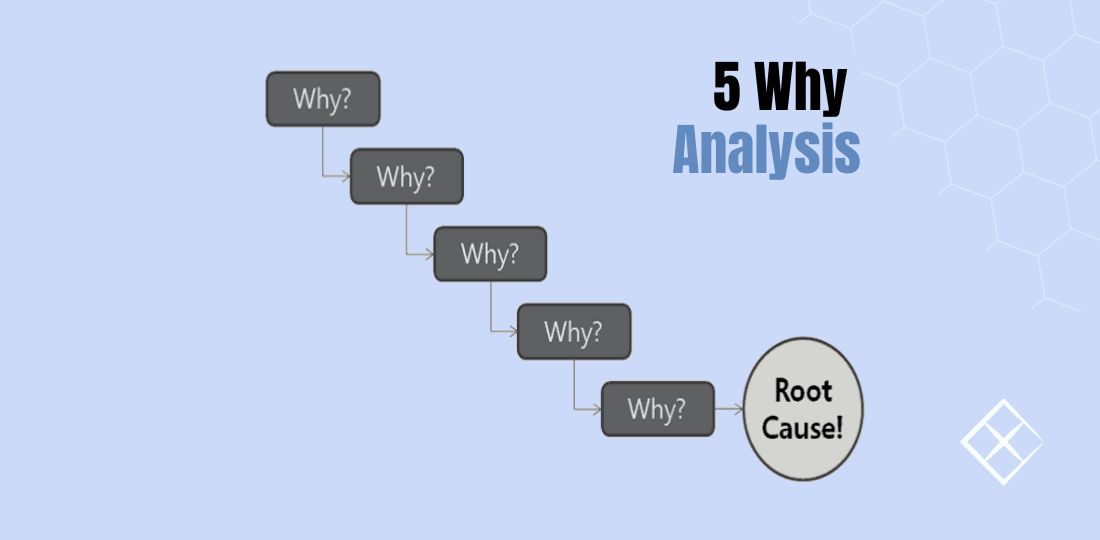5 Whys - Must-have tool for a root cause analysis
One of the best-tested methods of problem-solving has been the 5 WHYs Technique - introduced by Sakichi Toyoda, referred to as the King of Japanese Inventors, and practiced by the Toyota Motor Corporation.
The “5-Whys’’ technique is a systematic and effective problem-solving method that determines the root cause and effect of particular problems by progressively asking “why”. This is one of the simplest tools which are easy to complete without statistical analysis.
“5-Whys” helps identify the root cause of a problem. This technique also determines the relationship between different root causes of a current problem. According to anecdotal observations, 5 iterations of asking why is enough to reveal the root cause of a problem. Although sometimes, the analysis may take more or fewer whys depending on the depth of the root cause.
There is neither any stringent rule about the questions to be considered for an answer, nor is there a limit in time or depth to continue the search for additional root causes.
So, distinct sets of people, analyzing a similar problem using the 5 Whys method, could pursue different routes depending upon the knowledge and persistence of people involved.
When to use 5-Whys
The 5 Why Root Cause Analysis is a tool used to determine the role and accountability of human and system processes in the event of a human error. The 5 Why technique is used to understand the cause and effect of a problem to prevent similar occurrences in the future.
I will explain this below:
Managers often spend a lot of time resolving recurring petty problems. Adopting quick-fix solutions could be a common reason for recurring problems. And the managers sometimes can’t afford to repeat similar mistakes, owing to the criticality of the process. Every manager would like to detect the root cause of the problem and implement a permanent solution.
The benefits of 5 Why Analysis
- Helps to understand the nature of an organization’s operational problems and to devise collaborative solutions
- Its lean and structured approach helps to determine the root cause faster
- Doesn’t require special qualifications
- Considers the opinions of all stakeholders
- Minimizes the risk of hurting sentiments, because follows the Team-oriented problem-solving approach
3 key elements of the “5-Whys” technique
- an accurate and complete statement of problems,
- honesty in answering the questions,
- determination to dive deep into issues and get them resolved.
Note that not all problems have a single root cause. Distinct problems have different causes, and some problems have multiple causes. In such cases, you must repeat the 5 Whys method, asking a different sequence of questions for each specific cause.
The primary two techniques used to perform RCA method:
- Fishbone (or Ishikawa) diagram
- Tabular format (using EXCEL)
These tools allow the branching of analysis for multiple root causes.
Examples of 5-WHY Analysis
Problem (end-result): The room of Simon is in a mess.
-> ( Let’s start questioning using the 5 Whys )
1. Q: Why? (first why)
A: Simon couldn’t put his room in order.
2. Q: Why? (second why)
A: Simon returned home late at night, during the entire week.
3. Q: Why? (third why)
A: Simon was busy with a project that required him to meet deadlines.
4. Q: Why? (fourth why)
A: The Project deadline was advanced by a week.
5. Q: Why? (fifth why, the root cause)
A: Marketing the product was important. (The client considered project launch as per dates favorable to a positive market response).
The picture below shows another example:

The HISTORY of 5 Whys method
The original developer of this technique was Sakichi Toyoda, referred to as the King of Japanese Inventors and also called: “the Japanese Thomas Edison”. He used it as a critical component of training in problem-solving within the Toyota Motor Corporation, during evolutionary stages of its manufacturing methodologies. The architect of the Toyota Production System, Taiichi Ohno, described the 5 Whys method as “the basis of Toyota’s scientific approach - by repeating WHY five times, the nature of the problem and its solution becomes clear”.
Today 5 Whys method is widely practiced all over the world.
